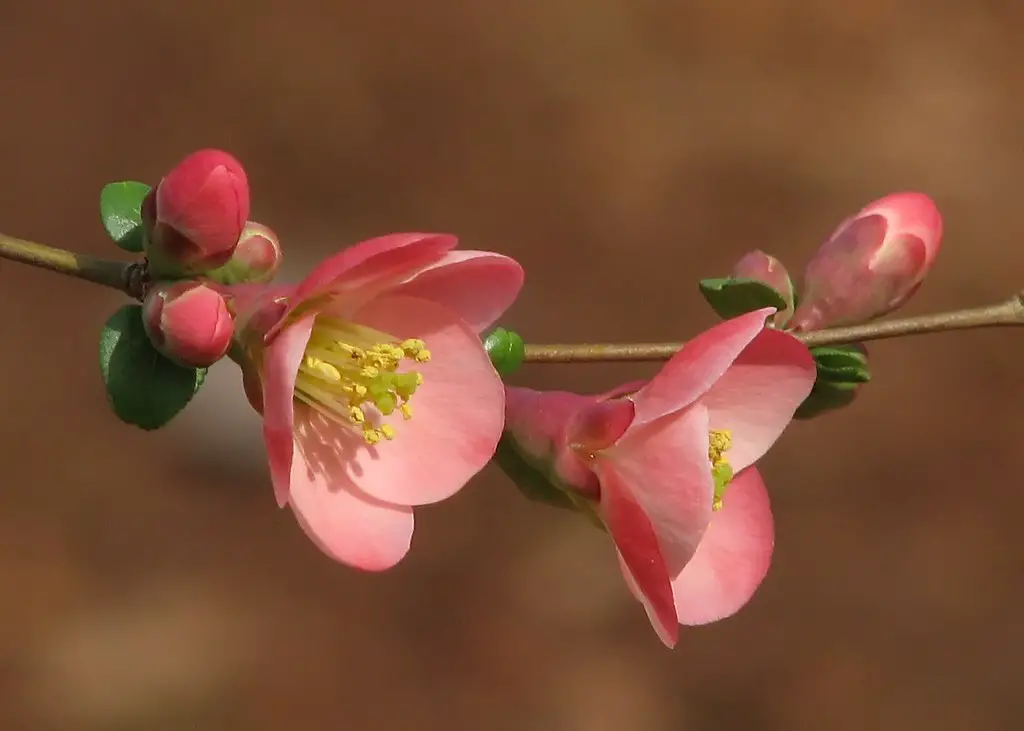Flowering Quince, a dazzling harbinger of spring, is known for its striking early bloom. This deciduous shrub bursts into bloom during late winter or early spring, with breathtaking flowers in shades of pink, red, orange, or white. Its branches can be laden with either simple single blossoms or extravagant double blossoms, often before the leaves emerge.
The charm of Flowering Quince doesn’t stop with its blooms. It also produces aromatic, apple-like fruit that can be used in jams and jellies. The branches with thorns are often used as an informal hedge or barrier. Though native to Eastern Asia, Flowering Quince has been cultivated in gardens around the world, celebrated both for its ornamental beauty and its fruit.
Despite its visual appeal, Flowering Quince is not a delicate plant. It’s a robust shrub that’s adaptable to various conditions, making it a delightful addition to gardens in many parts of the world. The allure of Flowering Quince, coupled with its hardy nature, has ensured its place in the hearts and gardens of many enthusiasts.
| Attribute | Details |
|---|---|
| Common Names | Flowering Quince, Japanese Quince |
| Botanical Name | Chaenomeles speciosa |
| Family | Rosaceae |
| Plant Type | Deciduous Shrub |
| Mature Size | 6-10 feet in height, 6-10 feet in spread |
| Sun Exposure | Full Sun to Partial Shade |
| Soil Type | Well-drained soil, tolerant to various types |
| Hardiness Zones | 4-9 |
| Native Area | Eastern Asia |
Flowering Quince Care
Flowering Quince is valued not only for its beauty but also for its easy care. This adaptable plant can thrive in various soil types and light conditions. Although it blooms more profusely in full sun, it can tolerate partial shade.
Watering and fertilizing are generally minimal, especially once the plant is established. It’s relatively disease-resistant and tolerates drought conditions, making it a low-maintenance choice for many gardeners.
Light Requirement for Flowering Quince
Flowering Quince performs best in full sun but can also tolerate partial shade. In shadier spots, the plant might produce fewer flowers, but it will still grow robustly.
Soil Requirements for Flowering Quince
This shrub is adaptable to a wide range of soil types, including sandy, loamy, or clay soils. Well-drained soil is preferred, and Flowering Quince can even tolerate poor soil conditions.
Water Requirements for Flowering Quince
Flowering Quince has moderate water needs. Regular watering is essential during its first year to establish the roots, but once established, it is quite drought-tolerant.
Temperature and Humidity
Flowering Quince is adaptable to various temperature ranges, flourishing in USDA zones 4-9. It’s not particularly sensitive to humidity levels, making it suitable for different climatic regions.
Fertilizer
Flowering Quince doesn’t require heavy fertilization. A balanced, slow-release fertilizer applied in early spring can support healthy growth and flowering but is often not necessary.
Pruning Flowering Quince
Pruning helps maintain the shape and encourages vigorous growth. Cutting back old wood immediately after flowering allows the plant to develop new growth for next year’s blooms.
Propagating Flowering Quince
Propagation is generally done through cuttings or layering. Cuttings can be taken in summer, and layering can be performed in spring or fall. The plant can also be divided at the root in early spring.
How To Grow Flowering Quince From Seed
Growing Flowering Quince from seed is a slow process and requires patience. The seeds need to be stratified and then sown in well-draining soil. Germination can take several weeks to months.
Common Pests & Plant Diseases
Aphids
Aphids can be controlled by natural predators or insecticidal soap.
Fire Blight
Fire blight can be a serious issue but can be managed with proper pruning and disposal of infected parts.
Common Problems With Flowering Quince
Sparse Blooms
Sparse blooms might result from inadequate sunlight or improper pruning.
Suckering
Excessive suckering can lead to an unruly appearance, and regular removal can maintain the desired shape.
Pro Tips
- Plant Flowering Quince in a sunny spot for abundant blossoms.
- Prune right after flowering to shape the shrub and encourage new growth.
- Water regularly during the first year for robust root establishment.
- Enjoy the fragrant fruit for culinary uses, if desired.
- Consider planting in a mixed border or using as a barrier plant due to its thorny branches.




